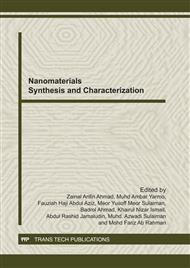p.228
p.232
p.238
p.243
p.248
p.254
p.260
p.266
p.272
The Effect of Calcinations Temperature on the Performance of TiO2 Aggregates-Based Dye Solar Cells (DSCs)
Abstract:
Development of novel TiO 2 nanostructures as the photo-electrode material is one possible solution to control the competition between electron generation and recombination which is the main constraint of obtaining higher conversion efficiency of dye solar cell (DSC). By manipulating the synthesis process, desired TiO2 nanostructure with specific properties can be obtained to enhance solar energy conversion efficiency. In this study, the effect of calcinations temperature towards physico-chemical properties of synthesized TiO2 aggregates and their influence on overall light conversion efficiency of DSC has been investigated. TiO2 aggregates (0.45 µm) composing of nanocrystallites (10-40 nm), were synthesized through hydrolysis of dilute titanium alkoxide in ethanol. The synthesized samples have been characterized using FESEM, XRD and UV-Vis spectroscopy. DSCs were then assembled and evaluated using solar simulator under 100 mW/cm2 illuminations. The size of nanocrystallites was found to increase with increasing calcinations temperature where the 500°C produced the 21 nm sized nanocrystallites, the optimum size for highest absorption of the dye resulting in the highest efficiency. TiO2 aggregates-based DSC demonstrated better performance compared to nanoparticles (P-25)-based DSC. This is attributed to the enhanced scattering introduced by micron-sized aggregates.
Info:
Periodical:
Pages:
248-253
Citation:
Online since:
October 2011
Keywords:
Price:
Сopyright:
© 2012 Trans Tech Publications Ltd. All Rights Reserved
Share:
Citation:



